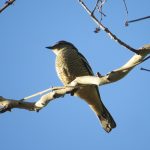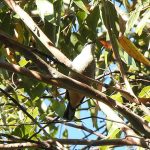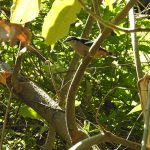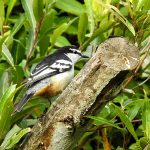VARIED TRILLER
The Varied Triller (Lalage leucomela)
The Varied Triller is a small, enchanting songbird that brings a touch of subtle beauty to Australia’s northern and eastern forests. With its gentle voice and understated plumage, this bird is a quiet presence in the treetops, often noticed only by those who pause to observe the intricate patterns of life in the canopy.
Physical Description
- Size: About 16–18 centimetres long, light and nimble.
- Plumage:
- The back, wings, and head are a smooth, shiny black.
- Underparts are bright white, clean and crisp.
- Soft grey or olive tones may be visible on the sides and flanks.
- Lacks the bold white wing patch seen in its close relative, the White-winged Triller.
- Eyes: Deep, dark, and alert, always scanning for movement.
- Bill: Slightly curved and sharp, perfect for picking insects from leaves and bark.
Imagine the bird perched quietly in the dappled shade, its dark feathers catching flecks of sunlight, while its white belly glows softly beneath the green canopy.
Habitat and Distribution
- Preferred Environment:
- Rainforests, monsoon forests, mangroves, and dense woodlands
- Found along the tropical and subtropical coasts and river systems
- Range:
- Eastern and northern Australia, from Cape York Peninsula down to central New South Wales and across to the Kimberley region in Western Australia
- Also found in New Guinea and nearby islands
In these lush environments, the air is thick with moisture and the smell of rich earth. The Varied Triller moves quietly among the foliage, almost invisible against a backdrop of shifting green.
Behaviour and Diet
- Social Structure: Often seen alone or in pairs, but sometimes joins small family groups.
- Feeding Habits:
- Primarily insectivorous, picking beetles, caterpillars, and spiders from leaves and branches.
- Eats fruit and berries when available, contributing to seed dispersal in the forest.
- Movement:
- Agile and active, hopping and fluttering through the canopy with quick, purposeful movements.
- Rarely descends to the ground.
You might hear a soft rustle as it moves, or catch a flash of white as it turns, always alert and ready to vanish into the leaves.
Vocalisations
- Song: A series of sweet, rolling trills and whistles.
- Purpose: Used to communicate with mates and young, and to mark their territory.
- Soundscape: Its song blends with the chorus of other forest birds, creating a gentle, musical background to the morning air.
If you listen closely at dawn, you may hear the Varied Triller’s melodic notes weaving through the symphony of the forest.
Breeding and Life Cycle
- Breeding Season: Mainly from September to February, depending on the region.
- Nest: Small, cup-shaped, built high in a tree fork, carefully woven from fine twigs and lined with soft materials.
- Clutch Size: Usually 2–3 eggs, pale and lightly speckled.
- Parental Care: Both parents share duties, from incubating the eggs to feeding the chicks.
The nest is hidden among leaves, safe from predators and shaded from the sun, a quiet cradle for the next generation.
Conservation and Importance
- Status: Not currently threatened; populations are stable in suitable habitats.
- Role in Ecosystem:
- Controls insect populations.
- Helps disperse seeds, supporting forest regeneration.
- Conservation Message: While the Varied Triller is secure, it relies on healthy, undisturbed forests. Protecting these habitats ensures not only the survival of this species but also the intricate web of life that depends on them.
In Summary
The Varied Triller is a symbol of Australia’s rich, hidden biodiversity—a quiet guardian of the leafy heights. By learning to appreciate its unique story, we are reminded of the importance of looking closely, listening carefully, and cherishing the natural wonders around us.
Next time you find yourself beneath the canopy of an Australian forest, take a moment to listen. The gentle song of the Varied Triller may be closer than you think, a quiet thread in the vibrant tapestry of the wild.




